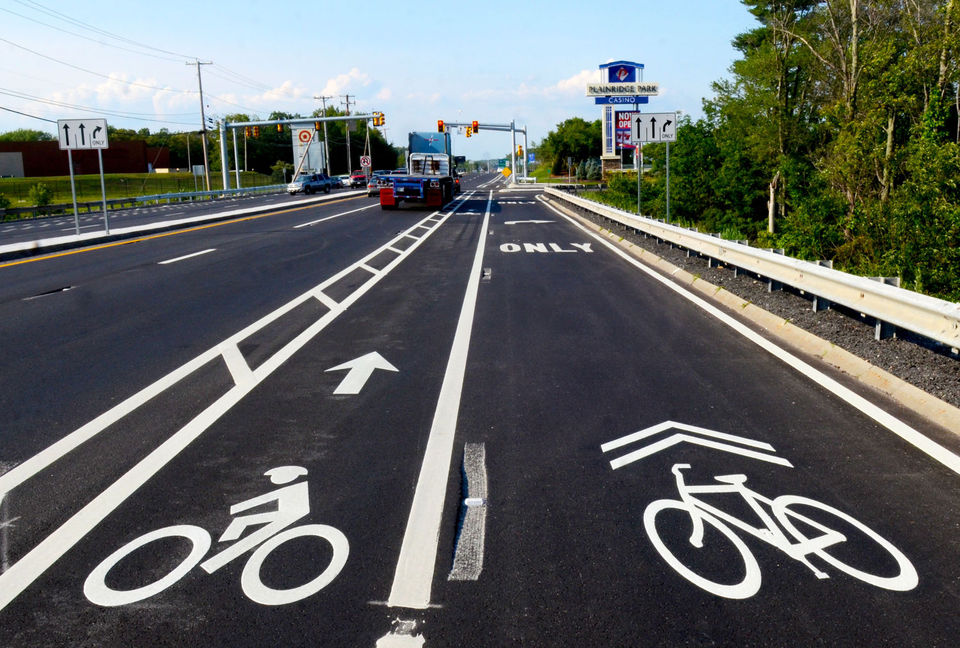The town manager in Plainville, Massachusetts, has complained about a new bike lane which has been installed in connection with upgrading of a casino by the side of Washington Street, US Route 1. He thinks that the bike lane should be removed, because he considers it unsafe. You may hear about this in a news story including video on the TV Channel 10 Web site.
[Archived, in case it is deleted]
[Video, which does not play in the archive]
The design of the bike lane is, however, correct in some ways which the town manager and the news reporters do not mention and evidently do not understand. Right-turn lanes are to the right of the bike lane at the entrance to the casino and a Route 495 on ramp, so motorists merge across the bike lane before turning right, rather than cutting off (“right-hooking”) bicyclists as they turn right. There is a buffer between the bike lane and the through lane, for clearance from passing motor traffic. With the new traffic signal at the casino entrance, this section of Route 1 is less of a speedway than it once was.

Not clear in the still image from the video on the Web page, but clear in a photo in a Sun Chronicle newspaper article, reproduced here, [also archived but paywalled] is that the project includes 5-foot long slots for sunken reflectorized pavement makers, which can steer the wheels out from under a bicyclist, and should never be installed anywhere except on a limited-access highway. Also, there is no sidewalk.
Comments by the TV reporter that the bike lane starts and ends abruptly might be taken further. A bicyclist must pass an on-ramp, an off-ramp and another on-ramp after the end of the bike lane at the Route 495 intersection. Before each on-ramp, there is a concrete rumble strip, see Google Street View.
Tellingly, while the town administrator complains that bicycling is unsafe, he never mentions the lack of a sidewalk. His approach to safety is to eliminate bicycling, and as walking has already been effectively eliminated, he doesn’t even have to mention it. We can all drive cars, and so we can all be safe.
The TV reporter complains that he has to cut across a travel lane to reach the bike lane. Well, yeah, that is called a lane change, and any bicyclist needs to practice it as a matter of course, because it is necessary on any street, even on shared-use paths when the person in front of you is a pedestrian or a slower bicyclist. The reporter skids his rear wheel at the end of the video. It’s painful to watch — this kind of skid wears a tire out after only a few stops. Whether the reporter does that for effect or just because he doesn’t know how to use the brakes, I don’t know. And, as he skids, his front tire looks quite soft.
Neither the town administrator nor the TV reporter accounts for differing skill levels of bicyclists. In the Sun-Tribune article, Richard Fries of Massbike is interviewed and properly makes the case for education and law enforcement, but also, a situation which looks unsafe and in fact is unsafe for a child, novice or untrained cyclist may be entirely reasonable for a skillful, adult cyclist. Traffic conditions also vary greatly from hour to hour and day to day. I might sometime have the opportunity to put those statements to a test by actually riding through the installation, and if so, you’ll read about that here. I’ll take care though to avoid the slots in the pavement and the rumble strips.
Actually, it does appear that there is another entrance to the casino, on a path through the woods from quiet Mirimichi Street, off Route 152– see Google Earth aerial view. This entrance may have been used only during construction, or it may be for a utility connection or emergency access. An alternate emergency-access route is often required in case a main access is blocked — but also, an alternate entrance is often gated, and often only emergency responders are allowed to use it.
North of Route 495 interchange, Route 1 actually is, if noisy and unpleasant, easy to ride and walkable, with wide shoulders paved to the same standard as the travel lanes — see Google Street View. South of Route 495, into the built-up part of Plainville, much of Route 1 could be described as a “traffic sewer” bordered by guardrails or by parking lots which come right up to the side of the travel lanes.
Bicycling and walking conditions were once tolerable on most of on Route 1. Degradation has occurred over a span of decades, with the worst insult being the Route 495 interchange. There are also no pedestrian crosswalks at the Route 152 intersection, see Google Street View. Well, there’s a logic to that, as there are no sidewalks to connect to crosswalks. As the area has become more built up over the years, more and more useful short trips might have been made on foot or by bicycle, but instead, they have been shut out bit by bit through highway redesign and non-planning of land use, in a death of a thousand cuts.
The bike lanes are a first, though certainly imperfect and incomplete attempt to remedy the situation. Fully accommodating bicyclists and pedestrians, though, would require a designated bicycle and pedestrian entrance to the casino, sidewalks along Route 1, and preferably an alternate crossing of Route 495 for bicyclists.
Who might cycle or walk to and from the casino? Employees, and people who had made one too many trips there already and had to sell their cars 🙂 There are people with other trips to make, too, including residents of nearby neighborhoods.

Leave a Reply
You must be logged in to post a comment.